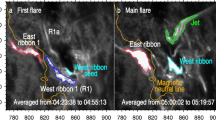Abstract
A study of the properties of the cosmic radiation of energy ∼- 10 MeV generated by solar flares is reported. Data from four Pioneer spacecraft in interplanetary orbits, and separated by ∼ 180° in heliocentric longitude are employed. Attention is restricted to the properties evident at times in excess of 1 day after the occurrence of the parent flare. The anisotropic character of the radiation; the gradients in heliocentric longitude; the decay time constants; and the energy spectra of the radiation are all studied in detail.
It is found that the equilibrium anisotropy assumes a direction ∼- 45° E of the satellite-Sun line at very late times. It is suggested that the anisotropy at such times is parallel to E × B. This observation confirms that convection is the determining process in the escape of the solar cosmic rays from the solar system. It indicates that a positive radial gradient of solar cosmic radiation density has builtup at orbit of Earth some 4 days after a flare. This results in an effective convective velocity of approximately 1/2 the solar wind velocity. Direct measurements indicate the presence of strong gradients in heliocentric longitude even at very late times (≳ 4 days). These gradients are essentially invariant with respect to time, e-folding angles of n ∼- 30° have been observed at ∼- 10 MeV. The presence of these gradients has a major effect on the temporal variation of the cosmic ray flux during the decay phase of the flare effect. Thus, the observed decay time constant is either increased or decreased relative to the ‘convective’ value depending on the position of the observer relative to the centroid of the cosmic ray population injected by the flare. The effect of the gradient becomes more pronounced at lower energies, and may even exceed the convective removal rate. The observed decay time constant, the characteristics of the anisotropy, and the gradient in longitude are shown to be inter-related as demanded by theory. It is shown that the exponent of the cosmic ray spectrum is dependent on the location of the observer relative to the centroid of the cosmic ray population injected by the parent flare. At a given point in the frame of reference of the cosmic ray population, the spectral exponent is invariant with time.
Similar content being viewed by others
References
Ahluwalia, H. S. and Dessler, A. J.: 1962, Planetary Space Sci. 9, 195.
Allum, F. R., Rao, U. R., McCracken, K. G., Palmeira, R. A. R., and Harries, J. R.: 1970 (under publication).
Bartley, W. C., McCracken, K. G., and Rao, U. R.: 1967, Rev. Sci. Instr. 38, 266.
Bukata, R. P., Keath, E. P., Younse, J. M., Bartley, W. C., McCracken, K. G., and Rao, U.R.: 1970, IEEE, Transactions in Nuclear Science.
Bukata, R. P., Rao, U. R., McCracken, K. G., and Keath, E. P.: 1971 (under publication).
Forman, M. A.: 1970, J. Geophys. Res. 75, 3147.
McCracken, K. G., Rao, U. R., and Bukata, R. P.: 1967, J. Geophys. Res. 73, 4159.
McCracken, K. G., Rao, U. R., and Ness, N. F.: 1968, J. Geophys. Res. 73, 4159.
McCracken, K. G. and Rao, U. R.: 1970, Space Sci. Rev.
Parker, E. N.: 1965, Planetary Space Sci. 13, 9.
Rao, U. R., McCracken, K. G., Allum, F. R., Palmeira, R. A. R., Bartley, W. C., and Palmer, I.: 1970 (under publication).
Smerd, S. F.: 1970, Proc. Astron. Soc. Australia, No. 7 (preprint).
Author information
Authors and Affiliations
Additional information
Now at CSIRO, G.P.O. Box 124, Port Melbourne, Victoria 3207, Australia.
On leave from Physical Research Laboratory, Ahmedabad, India.
Rights and permissions
About this article
Cite this article
McCracken, K.G., Rao, U.R., Bukata, R.P. et al. The decay phase of solar flare events. Sol Phys 18, 100–132 (1971). https://doi.org/10.1007/BF00146038
Received:
Issue Date:
DOI: https://doi.org/10.1007/BF00146038



